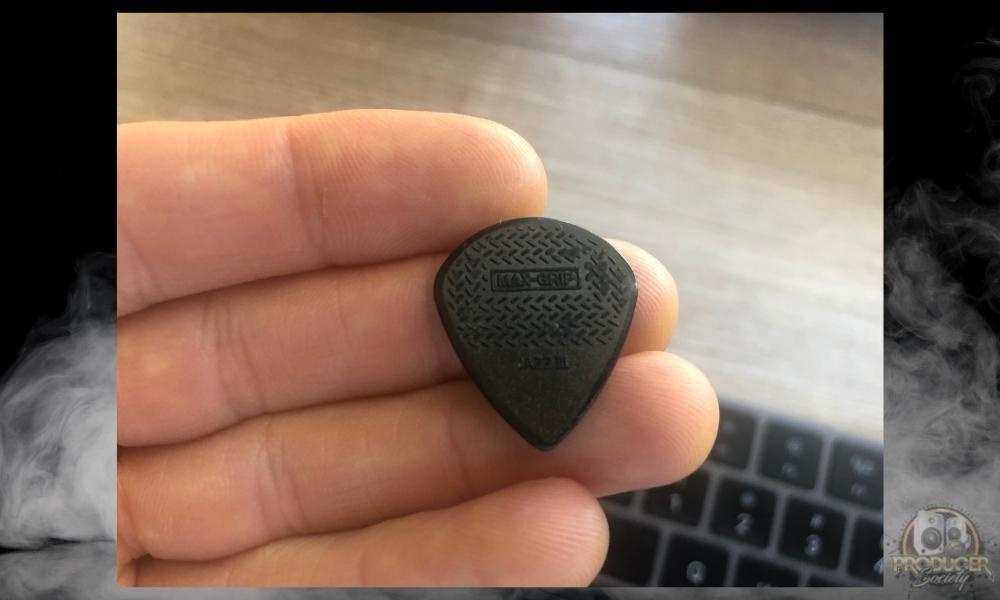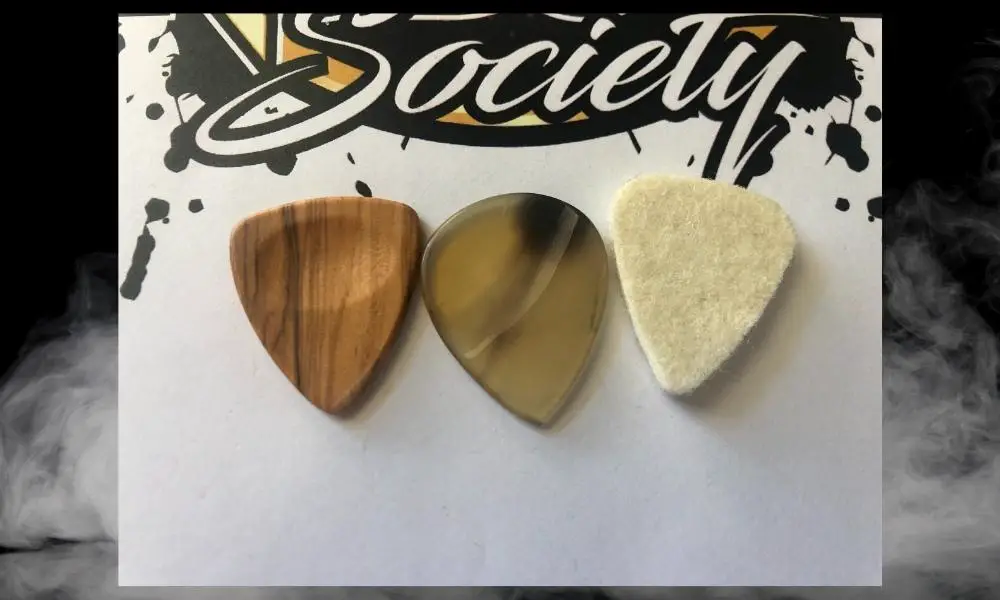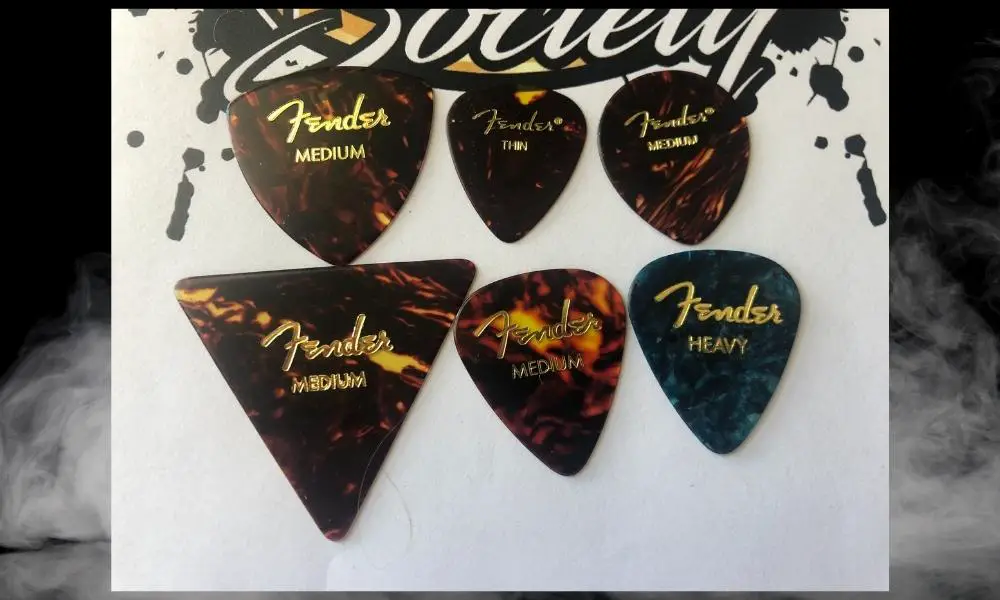Playing guitar like a pro is all about having complete control of your fingers. And to do that, you need to find a pick that fits you perfectly. While this is a personal preference, certain guitar picks are suited to specific music genres and guitar types.
When strumming, you need a flexible pick that cuts through the strings without resistance. So if you’re a rhythm guitarist looking for a comfortable pick for strumming, here’s the most important thing to keep in mind:
A nylon, Delrin, or celluloid pick between thicknesses of 0.45mm and 0.70mm are the best picks for guitar strumming, for both acoustic and electric. If you pick more often than you strum, or you’re using thicker strings, consider thicker picks over 0.75mm.
Since your playing style is a major factor, there are a few more things to consider before you find a pick that’ll truly allow you to play your best. And a quality pick made of good material can articulate a better tone as well. Let’s really get into this topic down below.
The Best Picks for Strumming on the Acoustic Guitar
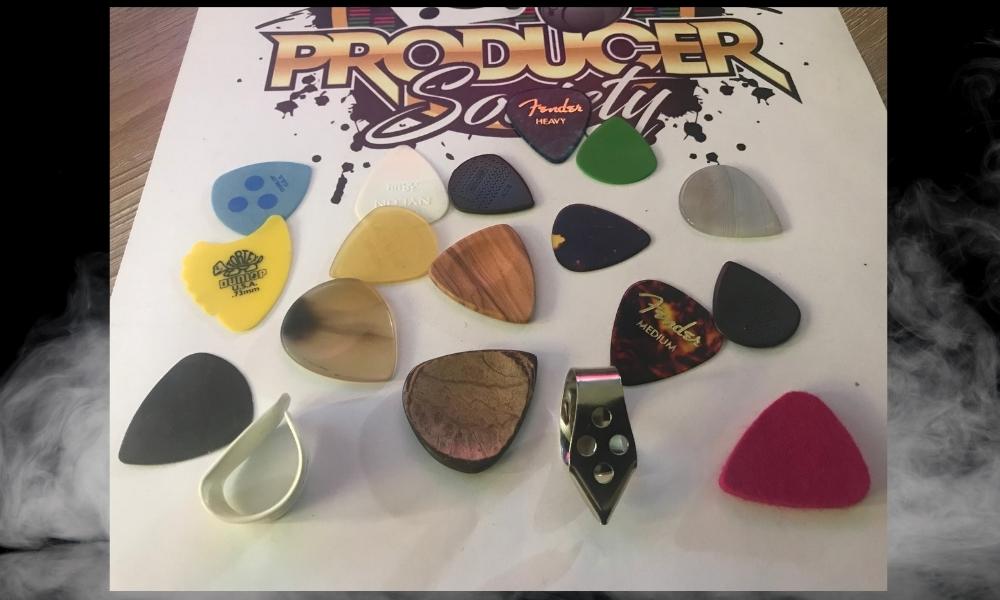
Picks improve accuracy and allow faster movement between guitar strings for many players. Using a good pick can also relieve weariness while being gentle on your fingertips.
Though some guitarists prefer to play with their fingers, not everybody can do it without regular practice, and switching between fingerstyle and picking requires additional practice.
Plus, continually strumming guitar strings with your fingers can cause blisters and end up being quite painful until you’re used to it.
Although, if you’ve read my article on playing the ukulele, you know that it’s actually the preferred way of strumming for many people, especially ukulele players.
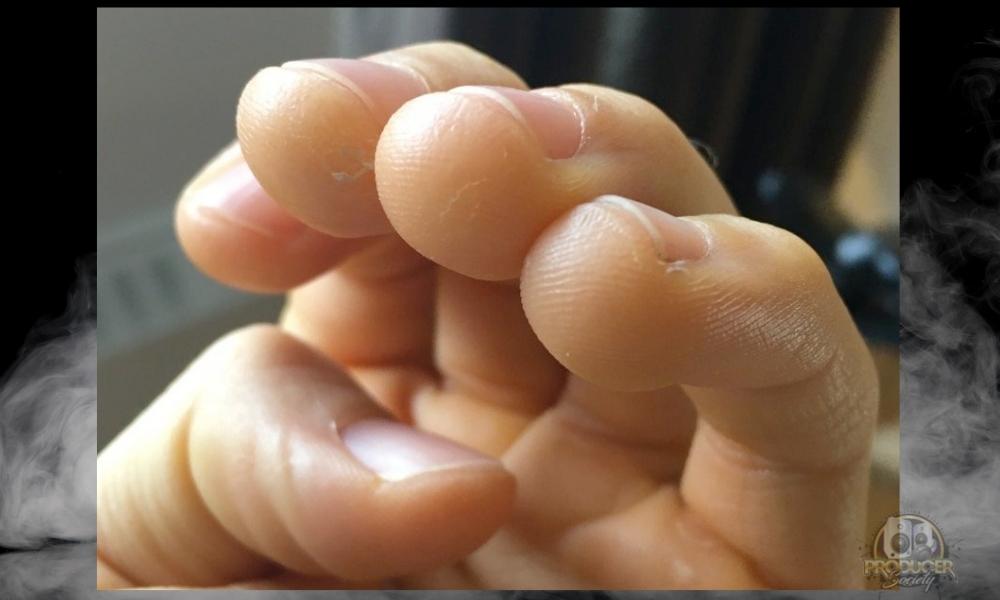
Using a pick also provides you with a couple of added advantages. For example, playing with a pick offers greater volume and brightness as it produces a more focused sound from the guitar, which isn’t possible if you are just playing with your fingers.
To choose the perfect pick for your acoustic guitar, you should keep the following factors in mind. Each of these factors influences not only your playability but also the tone of the guitar:
- The material of the pick
- The thickness of the pick
- The shape, including size, style, and design of the pick
Like Music Radar has pointed out as well, for an acoustic guitar, light to medium gauge picks made of nylon and celluloid with adequate flexibility provide a balanced response from the guitar and are ideal for most beginners. Here are the two I think are best:

You can find both of these on Amazon, however, I would get the Fender 346 Thin (on Amazon) that’s a bit wider so you have more to hold on to. I think a pick between .45mm and .55mm is the best for strumming, however, I prefer the 0.65mm Bulb Delrin pick.
The reason I prefer Misha’s Delrin pick (who goes by the name Bulb) that’s shown above is that it’s the best of both worlds. It’s thick enough that you can use it for fast alternate picking, but you can also use it for strumming if you need to.
What Kind of Pick is Best for Fast Strumming?
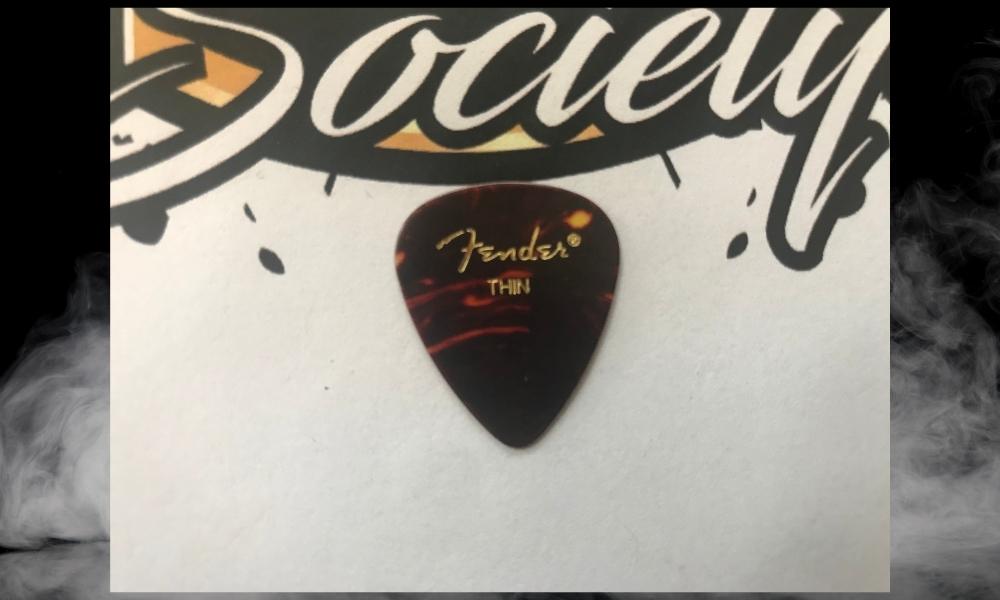
For fast strumming, a light or medium flexible pick works best. Different materials have varying degrees of flexibility, even if they have the same thickness.
As I said earlier, you should consider starting with nylon picks ranging from 0.45 to 0.65 mm in thickness if you want to do a lot of strumming. They’re the best for fast strumming, assuming you have regular string gauges (9-42 or 10-46).
Many guitarists prefer thin nylon picks because they are flexible, making strumming quite effortless as they strike the strings and provide less resistance. This leads to a smoother and brighter sound as well.
Celluloid picks like what’s shown above are also a popular choice if you’re looking for a brighter sound while strumming. As the plastic is highly flexible, it makes a percussive sound when it hits the string.
My personal preference, however, is to avoid the white .38mm white nylon picks. I find these are TOO thin, and too flexible, to the point where you make a significant sacrifice in tone.
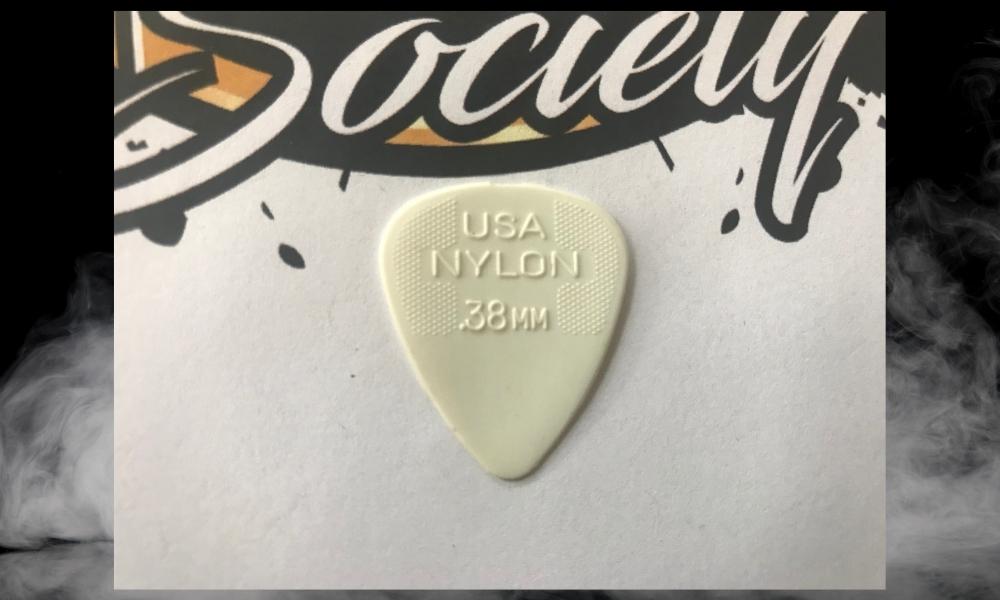
But with so many varieties of picks on the market, it helps to experiment a little and find the exact type of pick you find most comfortable and offers a good tonal response.
And then, I suggest buying at least a dozen of them. Like I said earlier, I own nearly every kind known to man. I even have one that’s made out of titanium, coconut, and stone.
Picks do make a difference in your playing, much to my surprise. I’m not sure why I’m surprised though because it makes perfect sense.
What Kind of Pick is Best for Strumming AND Picking?

When you’re picking a chord, like in an arpeggio, you need a guitar pick that offers proper control and attack to make the notes ring consistently. This is something I’ve learned over the years and many others agree with this sentiment.
If you find yourself unable to pick properly, try a thicker, more rigid pick. But if you find strumming difficult with such a pick, try something a bit more flexible.
Thicker picks like those between 0.50 and 0.65 mm are great options for strumming and picking. Because chord picking sounds quieter than strumming. Using something slightly thicker helps keep the volume even and clear.
Not only that but a thicker pick will help you hit the correct string when picking chords because there is enough rigidness and sturdiness to move on to the next note or string with enough speed. This is why shredders love the Jazz III.

Thinner picks are ideal for strumming, but they flex too much while chord picking, resulting in a loss of control and the incorrect string being struck. It has a bouncy quality to it that makes it hard to be accurate.
Nylon, celluloid, or Delrin are all excellent options, the most flexible being celluloid, which produces a bright, percussive sound. Nylon has a softer feel and a darker tone than celluloid, yet it doesn’t break as easily and is easy to grip.
Delrin (or Tortex) has the sharpest and most powerful tone of the three and is usually textured, making it easier to grip than celluloid or nylon.
It’s also generally the least flexible, so it requires some adjustment in playing technique to shift between strumming and picking. On the other hand, the Bulb pick is Delrin and it’s flexible enough, as is my green Tortex Jazz III which you can see here:

In any case, moving between strumming a fast chord progression and then picking an arpeggio will require practice, so I recommend practicing it at very slow speeds to get it consistently accurate.
The 2nd Best Pick for Strumming and Picking
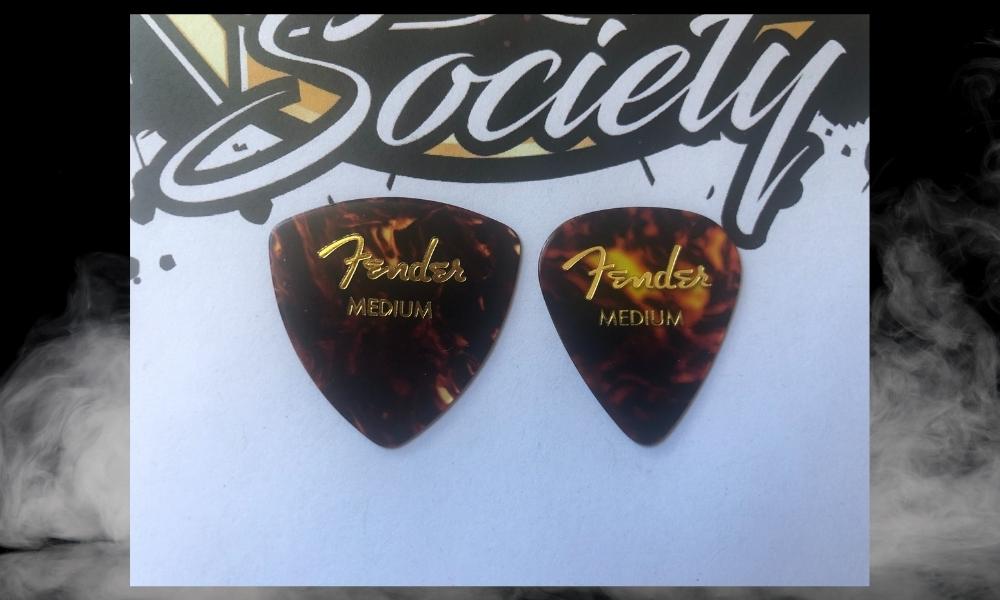
I can’t forget to mention the Fender Medium Celluloid pick. I believe this is also a great pick that could also be in the number one place in terms of what’s best for strumming and picking.
This pick is thicker than the Fender Thin celluloid which is 0.45mm, and it’s also wider so it’s easier to use. One thing I was thinking about is that if the Fender Thin were just 0.05mm thicker and wider and with an added grip, it would be the perfect pick.
When to Use Steel Picks and Plastic Finger Picks?
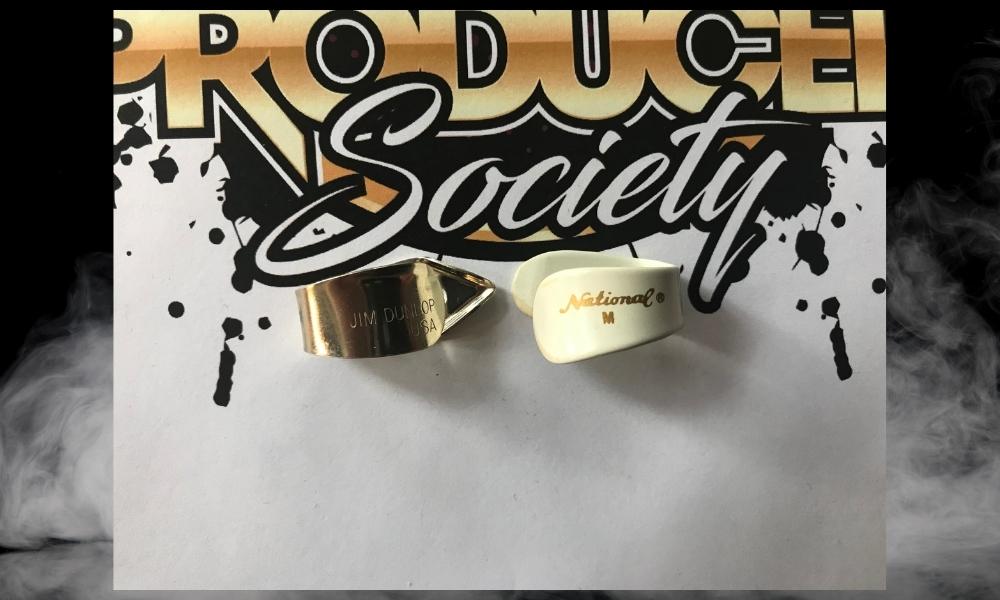
Finger picks are useful if you’re trying to play fingerstyle, but you don’t like having to strum and pick with your fingers. These picks help you maintain consistent volume and add a percussive attack to the sound. But they can make strumming a bit difficult too.
Metal finger picks are understandably louder than plastic finger picks. Metal finger picks are heavier and less sensitive than plastic finger picks, though plastic may be the way to go if you like less volume.
Metal picks are usually made with steel or brass, while plastic ones generally use celluloid. Try playing around with both of these combinations to see if the tone, feel, and reaction seems to work for you.
You can even mix and match metal and plastic picks. For example, you could wear a metal pick on your thumb for more attack, and use plastic finger picks on your other four fingers for fingerstyle picking.
People who are used to playing with normal guitar picks or using fingerstyle may find it hard to shift to using finger picks. Finger picks are commonly used on Hawaiian guitars.

So if you’re comfortable with normal picks and aren’t planning on learning fingerstyle, I recommend sticking to them. Normal picks are good enough for both acoustic and electric guitars, whether you’re playing a solo or just strumming some simple songs.
The Best Picks for Strumming on the Electric Guitar
Strumming on the electric guitar isn’t different from the acoustic guitar. The primary difference is that the electric guitar usually has thinner and lighter strings on it compared to its acoustic counterpart.
Another difference between the two is brightness. Most acoustics are much brighter, and also much louder than electric guitars by design. These are factors that you should take into consideration.
Medium-thick nylon picks are an excellent choice for someone new to the electric guitar. They offer the right balance of attack and flexibility while being easy to grip as well.
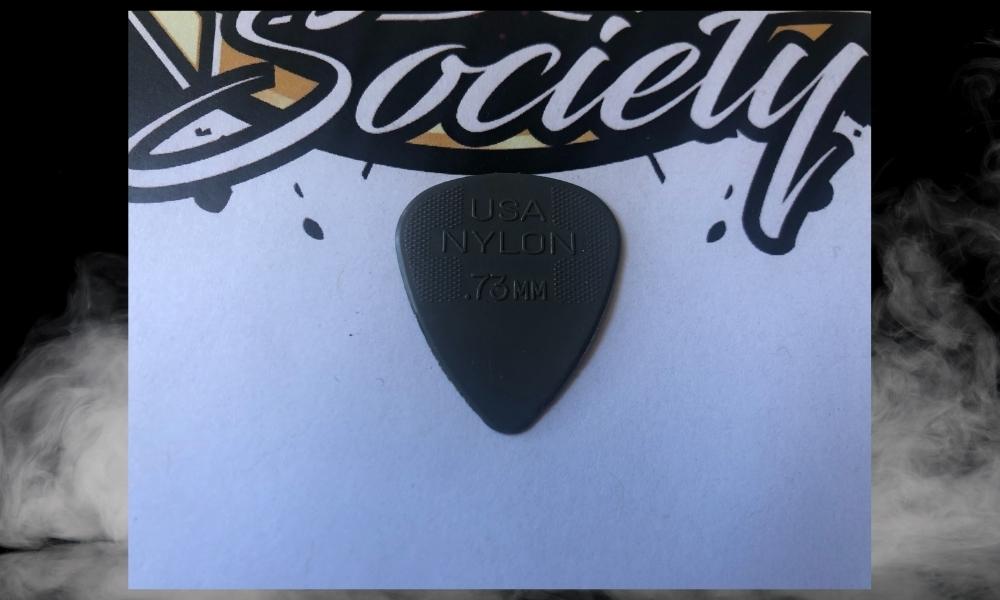
Electric guitarists who wish to play songs with heavy power chords and a strong sound should use heavier, thicker picks for greater attack as well as bass. The Fender Medium I showed above is great for this kind of playing.
Personally, my favourite pick to use is the Dunlop Carbon Fiber Jazz III MAX Grip. But I would say that I don’t like to use this one for strumming.
For the electric guitar, I’ll use the Bulb pick as well. The Jazz III is far too thick and pointy to be used for strumming.
What Kind of Pick is Best for Fast Strumming?
For strumming on electric guitars, I wouldn’t recommend using light picks, as electric guitars usually require softer strums and more nuance. The white Nylon 0.38mm is definitely not a good choice (for anything, in my opinion).
Since the pickup on an electric guitar amplifies all the frequencies from the strings, all the unwanted frequencies will make the sound muddy if you strum really hard on the electric guitar.
The best pick for strumming on the acoustic guitar is light-medium picks (nylon or celluloid – 0.50-0.70 mm). Although, a pick between 0.50mm – 0.60mm is deal for strumming
Also, try to strum gently. This requires more control, but it’ll lead to a better overall sound. And it works for both clean and crunch tones.
What Kind of Pick is Best for Strumming AND Picking?
Similar to acoustic guitars, if you’re planning on strumming and picking, you should use slightly thicker, more rigid picks. Medium-thickness picks are the most versatile in my experience.
They will produce more balanced tones and offer good picking control. A nylon or Delrin pick between 0.60 and 0.70 mm is a good choice for strumming and picking on the electric guitar, although, celluloid picks will be just fine for this as well.
As electric guitars usually have lighter gauge strings and are electronically amplified, you’ll find that they respond more dynamically to picking techniques. So practice working on your right-hand dynamics for better control, and you can articulate your sound better.
When to Use Steel and Plastic Finger Picks?
Finger picks aren’t that common on electric guitars – most fingerstyle guitarists stick to acoustic. So if you find that normal picks work well enough for you, I recommend sticking to them.
But if you’d like to try finger picks on an electric, start with medium-thickness celluloid ones. These will offer more control over strumming and picking, while metal ones might be too loud and offer too much attack for an amplified instrument.

The Relationship Between Guitar Pick Thickness and Strumming Technique
The gauge or thickness of the pick you choose has a significant impact on both tone and playability. Flexibility reduces friction between the pick and the strings, but weight adds bass and attack which is something Music Is Win argued on his channel as well.
Like this site pointed out and I agree, thicker picks are easier to grip, and they ‘cut’ through the strings easier. There isn’t a set standard for guitar picks as such, so the relationship isn’t always clear to beginners. That said, I can explain the sizes below.
Extra Light (0.38mm ~)

These guitar picks are known as extra thin or extra light. They typically range between 0.38mm to 0.45mm in thickness and are ok for simple and fast strumming. They’re very flexible, but they can also break quite easily.
My opinion is that they’re too thin, but I know beginners tend to like them. Thin picks have a brighter, percussive sound and are easier to play with. Celluloids are the most common material you’ll find in this range, but they’re usually not as easy to grip.
Probably what I dislike about super-thin picks the most is the “pluckiness” of them. The sound drives me crazy, and it’s something I also pointed out in the YouTube video that I made for this article.
If you’re a beginner and plan on strumming chords, then these are a good place to start. The flexibility helps you get your strumming patterns down easily. But they’re not suitable for picking, so sooner or later, you may have to transition to heavier picks.
Light (0.50mm ~)

The “light” variety of guitar picks typically range between 0.50mm and 0.70mm. Since these picks are just a little thicker than the extra light ones, they’re still very flexible and produce a bright sound from acoustic guitars. These are the best for strumming.
They’re very good for strumming, but sometimes too loose to play arpeggios and faster alternative picking riffs. Celluloid is very common here, but you’ll also find some nylon picks that are a bit stiffer and offer a better attack.
Medium (0.73mm ~)

Medium-sized guitar picks range in thickness from 0.70mm to 0.85mm. Many beginners choose to start with these picks size due to their versatility – both for strumming and picking.
They emphasize the mid-range frequencies in terms of tone and offer pronounced attacks. But since they’re a bit rigid, strumming fluidly with them may take some practice.
You’ll find both celluloid and nylon picks in this range, as well as Delrin or Tortex. Note that materials also influence the tone, durability, flexibility, and playing comfort, as I’ll discuss below.
Heavy (1mm ~)
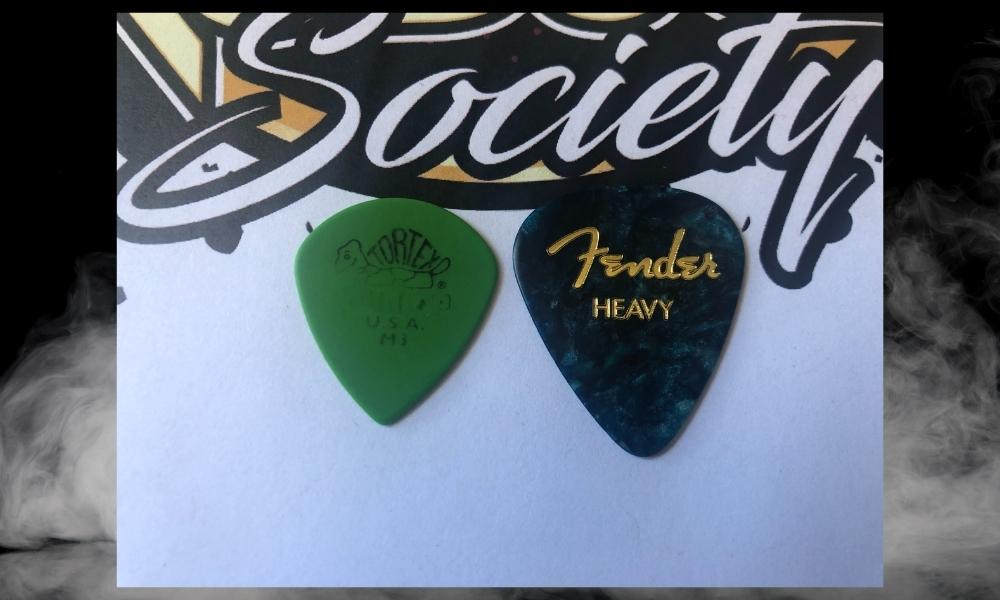
These are powerful guitar picks, ranging in thickness from 0.85mm to 1.20mm, with 1.0mm being the most common. They’re better suited to electric guitar players, as they offer better picking dynamics and articulations.
Strumming with these picks, particularly on acoustic, would be challenging to most beginners due to their stiffness.
But with proper right-hand control, you can get much better volume and projection using these heavy picks. Nylon, Delrin, and Tortex are all commonly used for heavy picks as well.
Generally the heavier you get, the harder it is to strum, so keep that in mind. I would stick to between light and medium guitar picks for strumming because anything about 0.70mm is going to be tough. Unless you love to play extremely hard and loud.
Extra Heavy (>1.30mm ~)
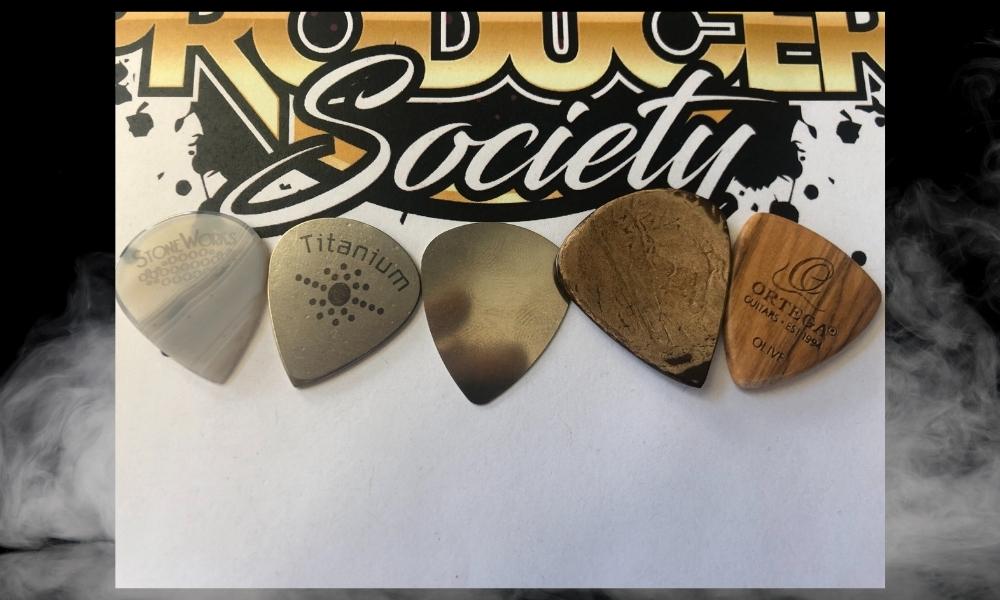
Extra-heavy picks give the player more control and accuracy, making them perfect for lead guitar but quite unsuitable for strumming acoustic guitar chords. They have a deeper tone to them, emphasizing lower frequencies.
With extra heavy picks, you get a sharp, defined pick attack with each note, giving you a much more articulated sound. If you’re planning on playing lead solos on an electric, these would be the perfect fit.
But strumming on an acoustic with such picks is not something I recommend. Due to their stiffness, you won’t get a fluid rhythm pattern unless you’re a great player who practices a lot.
However, if you alternate between both acoustic and electric guitar, it can help you correct poor strumming technique and make you a more versatile player.
In these extra thick picks, you have options between nylon and Delrin, but also rarer materials like wood, steel, and even stone. Keep in mind that these are only suggestions, and ultimately the thickness of your pick is a personal preference.
I’ve seen guitarists play fast arpeggios and scale runs with light picks, and players using heavy picks for acoustics as well – so there’s no limit to what you can do. Many ultimate-guitar forum users pointed this out as well.
Pick Material – How It Affects Sound & Playability
According to Fender, the bulk of picks produced nowadays are constructed from plastic compounds including celluloid, nylon, DuPont Delrin, xylonite, acrylic, and acetal.
Some natural materials such as stone, wood, ivory, and bone are also used but are usually rare and more expensive. I can confirm this because I’ve bought many kinds of picks and anything that isn’t plastic costs a lot more money.
Plastic picks remain the preferred choice of pick material amongst most guitar players. Your main consideration when choosing a pick should be how it feels in your hand.
If the comfort of holding the pick in your hand doesn’t feel right, you should try a different material. And some picks do last longer than others, so if you don’t want your picks to break while strumming, consider a more durable one like nylon or Delrin.
Before we dive in, one thing I would like to say is there isn’t a big difference in sound when comparing nylon, Delrin, and celluloid. The largest difference between picks lies in the thickness, rather than the material.
With a few exceptions like stone, titanium, felt, and wood picks (all of which do make a difference in my experience), most picks will sound very similar to one another.
Nylon

According to the Acoustic Guitarist, Nylon is a remarkably durable material that has long been the preferred choice of guitarists. Nylon picks are produced from very thin sheets of fibres. Generally, nylon offers a warmer tone compared to other materials.
Since nylon is a smooth and glossy material, the upper half of the pick is frequently friction-coated and textured to make it easier to hold. This enhances playability a lot, as the pick is less likely to fall out of your hands while strumming fast.
They sound fantastic on both electric and acoustic guitars, especially in lighter gauges when strumming. If you’re strumming and picking, then medium thickness works well.
Nylon picks come in a variety of thicknesses, so you’ll find ones anywhere between 0.50mm and 1.50mm and above. The thicker the pick, the stiffer it’ll be, and it’ll create a more pronounced pick attack.
Nylon guitar picks are commonly used by some of the most famous guitarists from rock, blues, and jazz. I think Nylon picks are probably better than Celluloid picks, but the thing about nylon is they’re usually uglier than celluloid picks.
The celluloid picks from Fender, for example, like the 351s, are probably the coolest-looking picks on the market.
Celluloid
Tortoiseshell, from the Hawksbill marine turtle, was used to make the bulk of guitar picks until the mid-70s. Tortoiseshell was a great material for both picks and pickguards since it was attractive, light, and robust.
Ever since it was declared endangered, pick manufacturers were forced to look for more sustainable alternatives. Since then, the majority of picks have been constructed from plastic compounds, including celluloid, tortex, and others.
Celluloid was created to have the same feel and tone as tortoiseshell. And hence, it’s frequently fashioned to look like a tortoiseshell or have a pearl-like texture and comes in a variety of creative colours.
These picks have a pronounced high end while strumming and are generally even more flexible than nylon, resulting in a snappier tone. You can find them across all varieties of thicknesses, but thick celluloid picks aren’t as popular as other materials.
Delrin/Ultex/Tortex
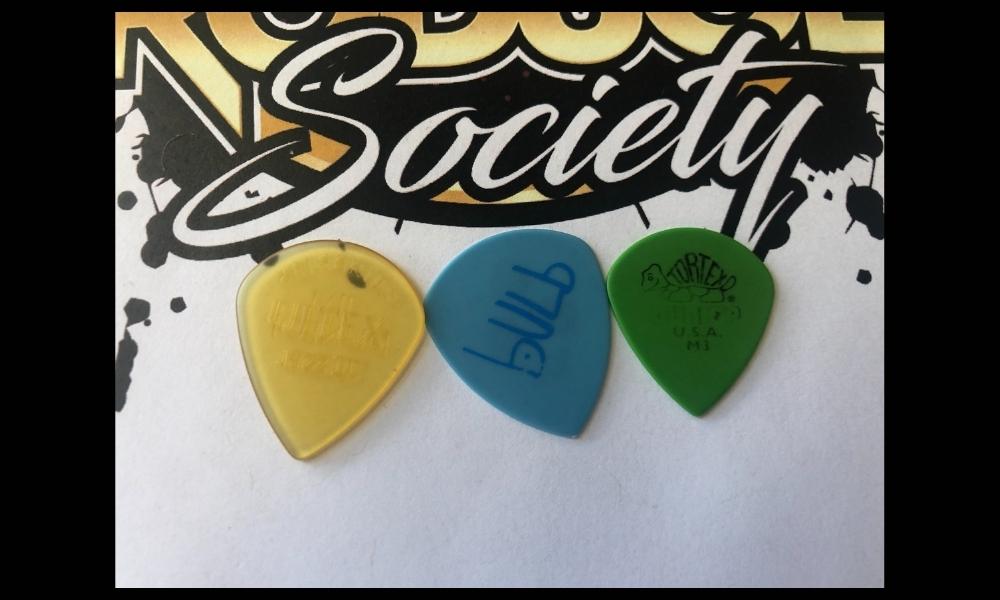
According to Premier Guitar, Dunlop first developed Tortex in 1981 as an alternative to tortoiseshell. To clarify, Delrin, acetal, tortex, and Ultex, are all essentially the same material.
Delrin is a patented plastic created by DuPont and utilized in prominent pick brands such as Dunlop’s Tortex and Ernie Ball’s Everlast. They are low-friction and they last forever. For real, it seems like these picks are good for life.
Acetal/Delrin picks are a decent choice for a beginner but are often preferred by intermediate and advanced players. It usually has a matte texture that improves grip and is quite rigid, adding brightness and a sharp attack on the strings.
Delrin quickly recovers to its standard shape after being deformed during play, resulting in a tone with a more robust high-end but also prominent bass. While it may be too stiff for fast strumming, it’s perfect for power-chord rhythms, riffs, and leads.
Dunlop’s Tortex picks have a powdery texture, which provides grip on your fingertips and friction against the strings. Tortex feels even ‘grippier’ than Delrin, even though they’re purportedly the same material.
Wood
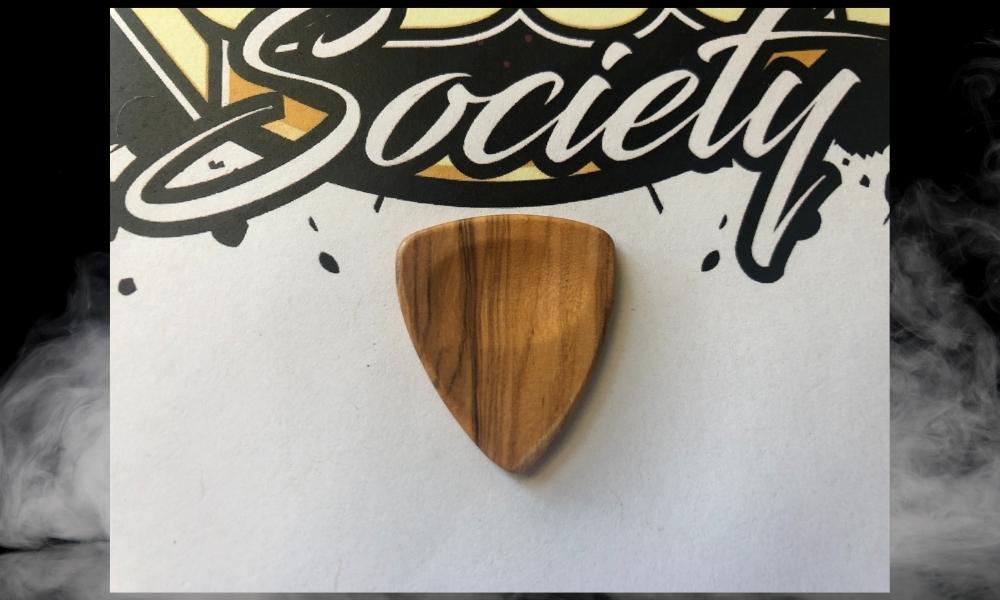
According to Wikipedia, wood picks can be made from rosewood, bocote, zebrawood, and several other hardwoods. There are many advantages to playing with a wooden pick and I would say the tone is a big one.
The most apparent is that they sound fantastic on acoustic guitars. You can get a wide range of tones out of a good wooden pick, however, I would argue they’re too rigid for strumming. I own 3 wood picks and they’re a bit too strong.
Wooden picks offer a warmer tone than other materials and are great for adding character to your sound. They feel fantastic in your hand, and some players find that they improve their picking technique.
The downside of wooden picks is that they wear out relatively quickly, so you’ll need to replace them frequently. They can also be quite expensive, especially if you’re prone to losing picks.
The first time I was ever exposed to a wooden pick was when I was a young kid. My guitar teacher had one and it was super big and bulky. They sound great for picking chords and arpeggios, particularly for jazz. They’re not great for speed though.
Steel and Titanium
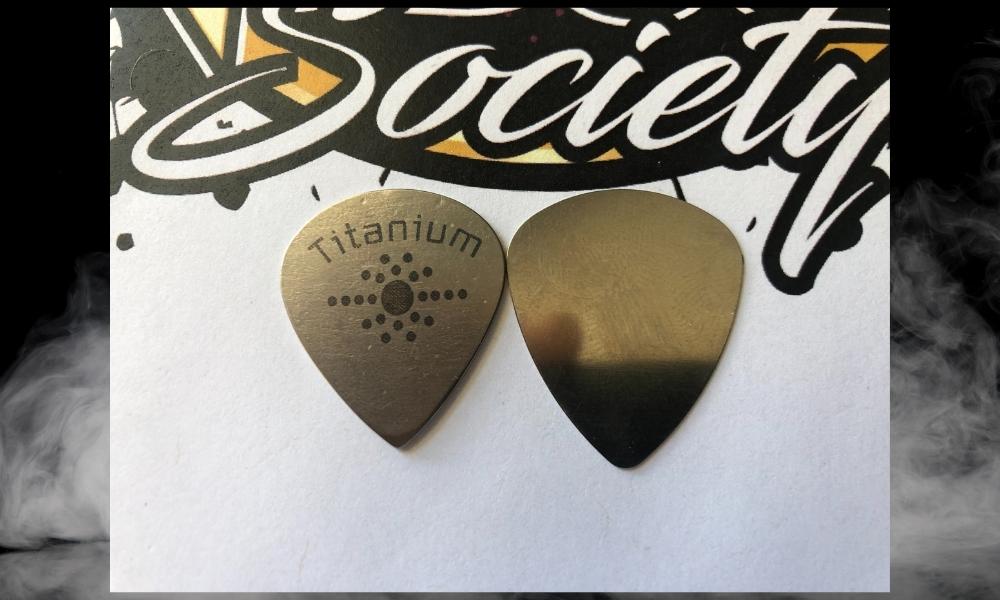
Steel or metal picks have only been around for a few years but have become increasingly popular in the last few years. Many people believe that metal picks provide the best attack and tone while strumming, but it can be difficult to get adjusted to them.
The material is also quite durable, so you won’t need to replace your picks as often. And since they come in a variety of thicknesses, you can find the perfect pick for your playing style.
The only downside of metal picks is that they can be quite slippery and challenging to grip. So they have a tendency to fly out of your hand while playing. Getting one with a textured grip can help.
Probably the main advantage of steel picks is they’re amazing for pick scrapes and pinch harmonics. You can really get some filthy pick scrapes with a steel or titanium pick.
Horn
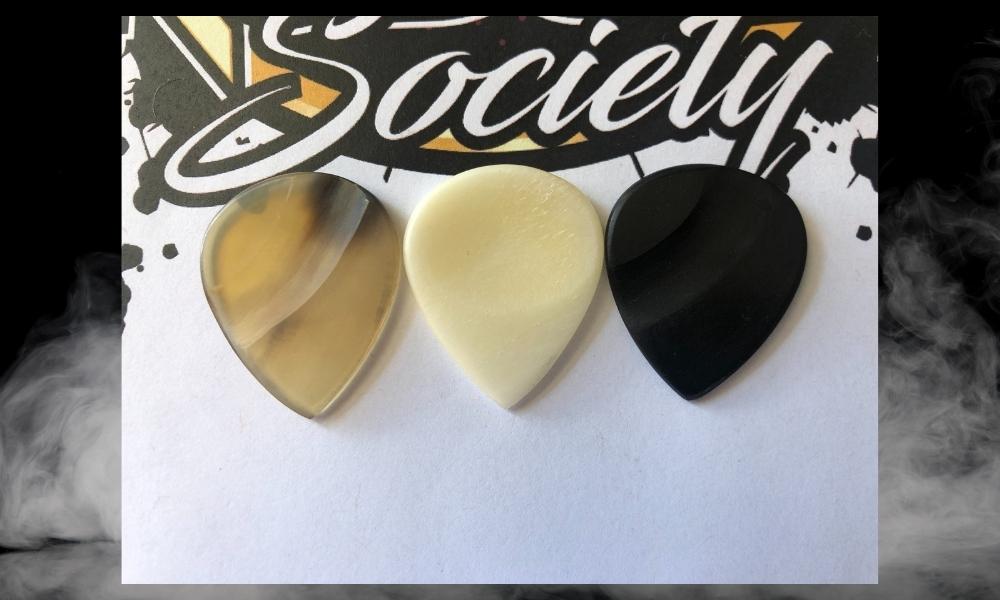
Unlike most other materials, horn and ivory are organic. They’re created from the tusks and horns of animals. As a result, no two picks made from horn or ivory will be similar in terms of color or grain.
Horn picks have been used by musicians for centuries and offer a natural look, feel, and tone. They’re beautiful, comfortable to hold, and offer a clear, articulate tone.
But they can be quite rare and expensive to find nowadays, with new environmental laws and endangered species. Hence, synthetic picks are a more viable and sustainable alternative.
I actually own a few horn picks, but I question whether they’re actually made out of horn or not. They were advertised as being made out of horn, but I’m not so sure.
Stone

While stone is not commonly used for guitar picks, some makers do use materials like agate, jade, and jasper (all different kinds of stones) for their manufacturing.
They feel surprisingly good in your hands, although a little stiff as might be expected from stone picks. They create a powerful pick attack and are great for playing some chunky rhythms. But strumming with these will be difficult since they’re significantly rigid.
I have two stone picks and 1 titanium pick from StoneWorks Picks which I learned about from this site, and I’m surprised by how much I actually liked them. I bought two of them, and both of them are kind of like Jazz III shapes as you can see in the image above.
I’ll probably reach out to the guy who made these stone picks and ask for a custom pick. I like the stone picks a lot.
However, I find they scrape the strings a bit too much in a weird way and they could use a grip on them. This is something I’d like to email the guy about, and I probably will at some point.
The Verdict
If you haven’t already, check out the YouTube video I made on this topic because I demonstrate every single type of pick that I talked about here.
From that experiment, I’ve chosen my favourite picks and listed them down here (make sure you experiment as well and make your own decision).
Best Pick for Strumming On the Acoustic Guitar:
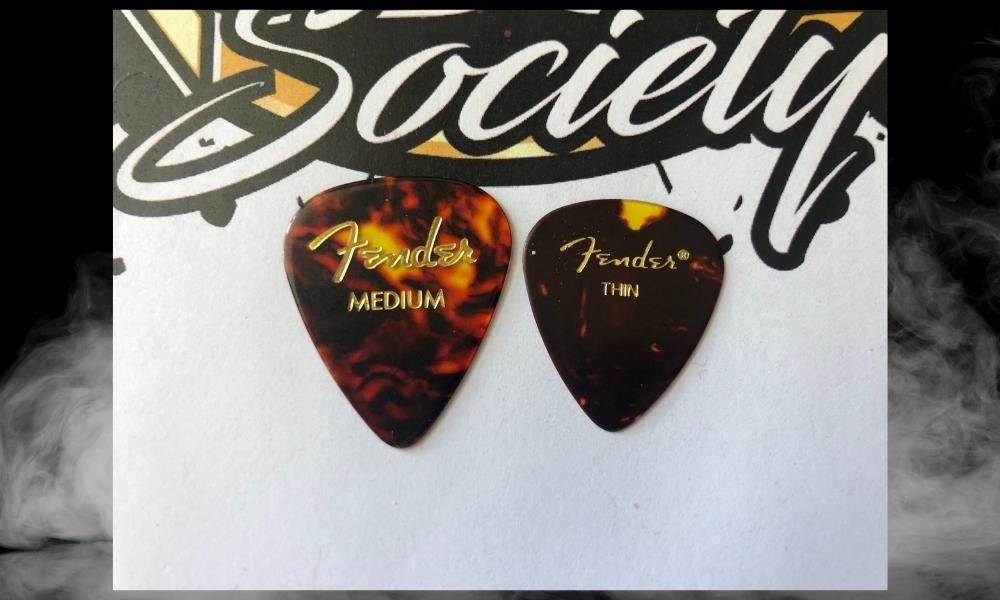
Best Pick for Strumming on Electric Guitar:
Most Versatile Pick (Picking and Strumming on Acoustic and Electric)

The ultimate winner is here is the Dunlop 0.65mm BULB Pick. The reason why I chose this pick is that if I were stranded on an island with two guitars, but only one pick, this pick would be able to do everything the best.
The 0.65mm BULB pick is a jack of all trades, but a master of none. It isn’t the best pick for alternate picking, nor is it the absolute best for strumming, but it sits right down the center of both, making it very good (but not perfect) for both.
This is the only way it can be. There can’t be a pick that’s perfect for strumming and fast alternate picking. With that said, I think you could find a similar pick to the Bulb 0.65mm that’s just as good or better.
Like I said before, if the Fender Thin 0.45mm (Celluloid) were just 0.10mm thicker, and wider, and they came with a grip, they could be the best pick on the market. Maybe I’ll have someone make me such a pick someday.
Important Things to Note About Picks and Strumming
1) Guitar String Thickness Is Also A Big Factor
Guitar picks change the way the string vibrates, which affects tone. But the thickness of your strings (their gauge) will also affect how the pick ‘attacks’ the string. Thicker strings tend to resonate more with deeper bass and longer sustain.
Guitarists usually find that thicker picks work well with thicker string gauges since they can ‘cut’ through strings more easily.
2) Beginners Will Most Likely Prefer Thin Picks When Starting
If you’re a beginner, the most important thing is to get a comfortable hand on the guitar and develop a strong sense of rhythm while strumming.
Thin picks are flexible and make it very easy to pick up any strumming pattern, and won’t tire you from overextended hours of play.
So I do recommend starting with a thin to medium pick and working your way up as you progress. Naturally, you’ll settle on a pick that works well for you, and then you can continue to develop your technique.


 Written By :
Written By :
